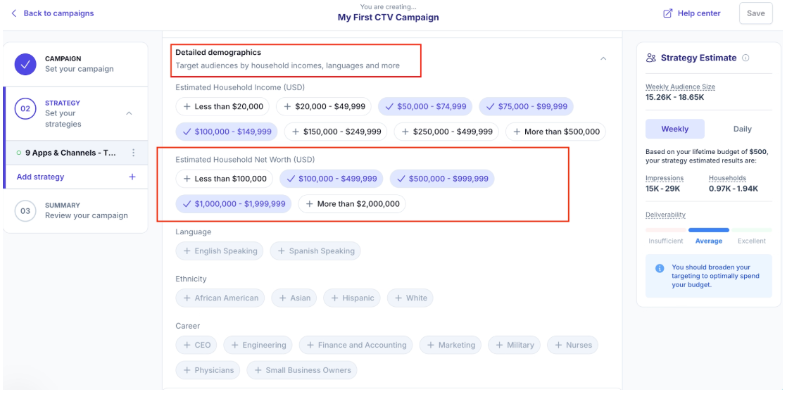Local TV vs. Cable TV Ads: Costs, Benefits & Best Strategies
When it comes to local TV advertising, should you choose local TV ads or cable TV ads?
Both can help you reach targeted audiences, but they differ in costs, targeting, and effectiveness—and making the right choice can impact your results.
In this blog, I’ll break down the key differences between local and cable TV ads, including costs per minute and strategies to get the most out of your ad spend.
Here’s What You’ll Learn:
✅ How local TV advertising works and how it differs from national TV ads.
✅ A cost breakdown of local vs. cable TV ad pricing.
✅ Proven strategies for running high-performing TV ad campaigns on both platforms.
If you're serious about growing your business, choosing the right TV ad strategy can save you money and deliver better results.
Let’s dive in and find out which one is the best fit for your next campaign!
What Is Local TV Advertising and How Does It Work?
Local TV advertising refers to ads aired on local broadcast TV stations (like ABC, NBC, or CBS) that target specific cities or regions.
This is different from national TV ads, which aim to reach people across the entire country.
To run a local TV ad, businesses work directly with TV stations in their area.
You'll select ad slots based on when your target audience is likely to watch.
Here’s how different types of businesses can use local TV ads:
- Local businesses: A bakery or gym can use local TV ads to target nearby customers and build brand awareness.
- Franchises: A fast food franchise opening a new location in a city may use local TV ads to spread the word.
- Political campaigns: Candidates often use local TV ads to connect with voters in specific areas before elections.
Local TV advertising helps businesses reach people in a specific region, and buying airtime through local stations allows you to customize your ad based on your target audience’s location and viewing habits.
Local TV vs. Cable TV Advertising: Which One Delivers Better Results?
When deciding between local TV ads and cable TV ads, it’s important to understand the key differences in how each targets audiences and the type of reach they provide.
While both are effective for local businesses, the choice depends on your goals, target audience, and budget.
Here's a breakdown of the differences:
| Feature | Local TV Ads | Cable TV Ads |
|---|---|---|
| Where Ads Appear | Broadcast on major local networks (e.g., ABC, CBS, NBC) | Air on cable channels (e.g., ESPN, CNN, HGTV) |
| Audience Reach | Reaches a wider audience within a city or region | Targets specific local markets more precisely |
| Targeting | Less precise, focuses on geographic area | Allows more detailed targeting (e.g., ZIP codes, interests) |
| Time Slots | More limited availability in prime time slots | More flexibility with ad placements and times |
| Cost | Generally lower than cable TV ads in large cities | Can be more expensive due to precise targeting |
If you're looking to reach a wide local audience, local TV ads may be your best option.
However, if you need to target specific demographics or interest groups, cable TV ads offer more precise segmentation, making it ideal for businesses that need to narrow in on a particular market.
How Much Does Local TV Advertising Cost? (Ad Rates Per Minute Breakdown)
The cost of local TV advertising depends on several factors.
Let's break it down so you can better understand what influences the price.
- Time Slot: Ads shown during prime-time (when most people are watching TV, like in the evening) cost more than ads shown during off-peak hours (like late-night or early morning).
- Channel Popularity: The cost also depends on how popular the TV network is. Big networks like ABC or CBS with higher viewer reach usually cost more.
- Market Size: The size of the city or region matters. Ad rates are higher in larger cities compared to smaller markets where there are fewer viewers.
- Ad Length: The longer your ad, the more it will cost. A 15-second ad is cheaper than a 30-second or 60-second ad.
- Seasonality: Prices can increase during special times like election seasons, holidays, or major events when TV viewership is higher.
Average Cost of Local TV Advertising (Per Minute Breakdown)
| Market Size | 15-Second Ad | 30-Second Ad | 60-Second Ad | Best For |
|---|---|---|---|---|
| Small Market (Local Channels) | $100 – $500 | $300 – $1,500 | $600 – $3,000 | Local businesses, startups, political ads |
| Mid-Sized Market (City TV) | $500 – $2,000 | $1,500 – $5,000 | $3,000 – $10,000 | Medium-sized businesses, franchise chains |
| Large Market (Metro & Major Networks) | $5,000+ | $10,000+ | $20,000+ | Big brands, national campaigns, high-budget advertisers |
Keep in mind that these prices can change depending on the demand, station, and location.
Understanding these factors will help you plan your TV advertising campaign more effectively and avoid any surprises when setting your budget.
How to Choose the Right Budget for Local TV Advertising
So, what do these numbers actually mean for your business?
Here’s a breakdown by business size and goals:
| Business Type | Recommended Budget | Best TV Ad Type | Alternative (If TV Costs Too Much) |
|---|---|---|---|
| Local Small Business (Restaurants, Salons, Gyms, etc.) | $500 – $3,000 per month | 15-30 second spots during off-peak hours | Facebook & YouTube Ads, Local Radio |
| Medium-Sized Business (Retail Stores, Auto Dealers, Local Franchises) | $3,000 – $15,000 per month | 30-60 second ads in prime-time or high-viewership slots | Mix of TV + Google Display/Streaming Ads |
| Large Business (Big Regional Brands, National Advertisers, Political Campaigns) | $50,000+ per campaign | Multiple ad slots across major local & cable networks | Programmatic TV Advertising (e.g., Vibe.co for targeted streaming ads) |
Is Local TV Advertising Worth the Cost?
Before committing thousands of dollars to TV ads, ask yourself: ✔ Do you need to reach a broad audience?
Local TV is great for mass awareness but lacks precise targeting.
✔ Can you afford multiple ad placements? A single ad won’t be effective; TV works best with repetition.
✔ Would digital or streaming ads be more cost-effective? Platforms like Vibe.co let you run targeted TV ads on streaming platforms for a fraction of the cost of traditional TV ads.
💡 Pro Tip: For small businesses, a mix of TV & digital ads (Facebook, YouTube, or Streaming TV) can often deliver better results at a lower cost.
Local TV Advertising vs. Digital & Streaming Ads: Which Offers Better ROI?
When deciding between local TV advertising and other options like digital ads or streaming TV ads, it’s important to consider what kind of return on investment (ROI) you’re aiming for.
Each platform has its strengths, and the choice depends on your goals, audience, and budget.
I. Local TV Ads:
Local TV ads are great for brand awareness and building local credibility. When people see your business on their local TV station, it helps create a sense of trust within your community.
These ads work well if your main goal is to reach a broad audience in your area, such as for local promotions, grand openings, or political campaigns.
II. Digital Ads:
Digital ads are typically cheaper and offer precise targeting, allowing you to focus on specific interests, behaviors, and demographics.
However, while they’re excellent for reaching potential customers online, digital ads have a harder time building the same level of local trust that TV ads do.
People might click on a Google ad or watch a Facebook video, but they don’t always form the same connection they do with a TV ad.
III. Streaming TV Ads:
Streaming TV ads provide the best of both worlds—they offer the TV-like engagement of traditional TV but with better targeting and more flexible pricing.
Streaming platforms, like Vibe.co, allow businesses to target audiences with data-driven insights, which can lead to a more efficient ad spend.

For example, Vibe.co lets businesses precisely target viewers based on demographics, viewing habits, estimated household income and net worth, all while keeping costs lower than traditional TV advertising.
Which Option Delivers the Best ROI for Your Business?
- Local TV Ads are a solid choice for wide local reach and building credibility.
- Digital Ads are better for precise targeting and often cost less, but they may not build as much local trust.
- Streaming TV Ads like those on Vibe.co combine the engagement of TV with the flexibility of digital—allowing for precise targeting at a lower cost than traditional TV.
Your decision should depend on whether you’re looking for broad, local awareness or more targeted, cost-effective advertising.
Is Local TV Advertising Still Worth It in 2025?
Local TV advertising has been around for a long time, and it's still a popular choice for businesses looking to reach people in their area.
But in 2025, is it still worth the investment? Let’s break it down with the pros and cons.
Pros of Local TV advertising:
- Brand Credibility: One of the biggest advantages of local TV advertising is the credibility it gives your brand. When people see your business on TV, it subconsciously places your brand in the same category as established, trusted companies. The common mindset is, “If they’re on TV, they’re probably good.”

- Great for Local Businesses and Campaigns: If you have a brick-and-mortar business or you're running a local political campaign, TV ads are an effective way to reach people nearby. It helps you build recognition and trust with your audience in your area.
Cons of Local TV advertising:
- Higher Costs Compared to Digital Ads: Local TV advertising can be expensive. You have to pay for the airtime, production costs, and more. This can be tough for small businesses or those with a limited marketing budget.
- Harder to Track Results: Unlike digital ads, where you can track every click and view, it’s harder to measure how well your TV ad performs. This makes it tough to adjust campaigns in real-time or fully understand your return on investment (ROI).
Many businesses are choosing to combine local TV ads with streaming TV ads (like those on platforms such as Vibe.co).
This way, they get the benefits of traditional TV ads’ broad reach, but with the ability to target specific audiences more effectively.
Plus, streaming ads are often more cost-effective and easier to track.
In conclusion, while local TV advertising remains a valuable tool for building community trust and reaching local audiences, it's essential to weigh its costs and measurement challenges.
Combining traditional TV ads with digital strategies like streaming can provide a balanced and effective marketing solution in 2025.
Conclusion
In conclusion, local TV advertising is still a strong option for reaching people in your area and building trust.
But when you combine it with digital or streaming ads, you can reach your audience more precisely and save on costs.
- Local TV ads help you get broad exposure and build credibility.
- Digital and streaming ads let you target your audience more accurately and are often more affordable.
If you're looking to make the most of your ad spend and get more targeted reach, consider Vibe.co.
It combines the power of TV with better targeting and lower costs, helping you get more out of your advertising budget.
Explore Vibe.co to see how it can work for your brand today.
FAQs About Local TV Advertising
1. What is local TV advertising?
Local TV advertising refers to ads that are shown on broadcast networks like ABC, CBS, or NBC, but only in specific local markets (e.g., cities or regions). These ads are typically targeted to local audiences and can help businesses build brand recognition in their community.
2. Is local TV advertising worth it in 2025?
Yes, local TV advertising is still worth it if your goal is to build credibility and reach a local audience. It remains effective for businesses, political campaigns, and community-based services. However, combining it with digital or streaming ads can enhance targeting and offer better cost-efficiency.
3. How does local TV advertising differ from cable TV advertising?
Local TV ads are aired on major broadcast networks (like ABC or NBC) within a specific region, reaching a broader audience in that area. Cable TV ads, on the other hand, are aired on cable networks (e.g., ESPN, CNN) and allow for more precise audience targeting, such as focusing on specific ZIP codes or demographics.
4. Can small businesses afford local TV advertising?
Yes, small businesses can afford local TV advertising by choosing off-peak hours and local stations with smaller audience sizes. Costs can be kept lower, and the impact can still be significant, especially when targeting specific local communities.



